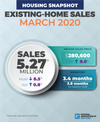WASHINGTON—Existing-home sales fell in March following a February that saw significant nationwide gains, according to the National Association of Realtors. Each of the four major regions reported a dip in sales, with the West suffering the largest decrease.
Sales in the Northeast dipped more than 7%, NAR reported.
Total existing-home sales, (https://www.nar.realtor/existing-home-sales), completed transactions that include single-family homes, townhomes, condominiums and co-ops, dropped 8.5% from February to a seasonally-adjusted annual rate of 5.27 million in March, according to the NAR report released on April 21. Despite the decline, overall sales increased year-over-year for the ninth straight month, up 0.8% from a year ago (5.23 million in March 2019).
“Unfortunately, we knew home sales would wane in March due to the coronavirus outbreak,” said Lawrence Yun, NAR’s chief economist. “More temporary interruptions to home sales should be expected in the next couple of months, though home prices will still likely rise.”
While sales have declined, home prices are still solidly strong. The median existing-home price for all housing types in March was $280,600, up 8.0% from March 2019 ($259,700), as prices increased in every region. March’s national price increase marks 97 straight months of year-over-year gains.
Total housing inventory at the end of March totaled 1.50 million units, up 2.7% from February, but down 10.2% from one year ago (1.67 million). Unsold inventory sits at a 3.4-month supply at the current sales pace, up from three months in February and down from the 3.8-month figure recorded in March 2019.
“Earlier in the year, we watched inventory gradually tick upward but with the current quarantine recommendations in place, fewer sellers are listing homes, which will limit buyer choices,” Yun said. “Significantly more listings are needed and more will come on to the market once the economy steadily reopens.”
NAR’s most recent Flash Survey showed that 93% of sellers changed behavior to help the homebuying transaction move forward with social distancing and necessary precautions.
Properties typically remained on the market for 29 days in March, seasonally down from 36 days in February, and down from 36 days in March 2019. Fifty-two percent of homes sold in March 2020 were on the market for less than a month.
First-time buyers were responsible for 34% of sales in March, up from both 32% in February and 33% in March 2019. NAR’s 2019 Profile of Home Buyers and Sellers—released in late 2019—revealed that the annual share of first-time buyers was 33%.
“Despite the social distancing restrictions, with many Realtors® conducting virtual open home tours and with mortgage rates on the decline, a number of first-time buyers were still able to purchase housing last month,” Yun said.
Individual investors or second-home buyers, who account for many cash sales, purchased 13% of homes in March, down from both 17% in February and 18% in March 2019. All-cash sales accounted for 19% of transactions in March, down from both 20% in February and 21% in March 2019.
Distressed sales—foreclosures and short sales—represented 3% of sales in March, up from 2% in February, and unchanged from 3% in March 2019.
“It is NAR’s top priority to continue to aid and assist Realtors during these unpredicted, trying times,” said NAR President Vince Malta, broker at Malta & Co., Inc., in San Francisco. “We have played an instrumental role on Capitol Hill as Congress secured multiple federal relief packages, and we will continue fighting on behalf of our 1.4 million members, American consumers and the nation’s economy as these conversations persist.”
“We have seen an increase in virtual home tours, e-signings and other innovative and secure methods that comply with social distancing directives,” Malta continued. “I am confident that Realtors® and brokerages will adapt, evolve and fight, ensuring the real estate industry will be at the forefront of our nation’s upcoming economic recovery.”
Realtor.com’s Market Hotness Index, measuring time-on-the-market data and listing views per property, revealed that the hottest metro areas in March were Colorado Springs, CO.; Modesto, CA; Manchester-Nashua, NH; Rochester, NY and Lafayette-West Lafayette, IN.
According to Freddie Mac, the average commitment rate (link is external) for a 30-year, conventional, fixed-rate mortgage decreased to 3.45% in March, down from 3.47% in February. The average commitment rate across all of 2019 was 3.94%.
Single-Family and Condo/Co-op Sales
Single-family home sales sat at a seasonally-adjusted annual rate of 4.74 million in March, down from 5.16 million in February, and up 1.3% from a year ago. The median existing single-family home price was $282,500 in March, up 8.0% from March 2019.
Existing condominium and co-op sales were recorded at a seasonally adjusted annual rate of 530,000 units in March, down 11.7% from February and down 3.6% from a year ago. The median existing condo price was $263,400 in March, an increase of 7.9% from a year ago.
Regional Breakdown
Compared to the month prior, March sales decreased in every region, while the Midwest and the South experienced increases in year-over-year sales. Median home prices in all regions increased from one year ago, with the Northeast and Midwest regions showing the strongest price gains.
March 2020 existing-home sales in the Northeast fell 7.1%, recording an annual rate of 650,000, a 3.0% decrease from a year ago. The median price in the Northeast was $300,400, up 8.3% from March 2019.
Existing-home sales decreased 3.1% in the Midwest to an annual rate of 1.25 million, up 4.2% from a year ago. The median price in the Midwest was $219,700, a 9.7% increase from March 2019.
Existing-home sales in the South dropped 9.1% to an annual rate of 2.29 million in March, up 0.9% from the same time one year ago. The median price in the South was $245,100, a 7.5% increase from a year ago.
Existing-home sales in the West fell 13.6% to an annual rate of 1.08 million in March, a 0.9% decline from a year ago. The median price in the West was $420,600, up 8.0% from March 2019.







